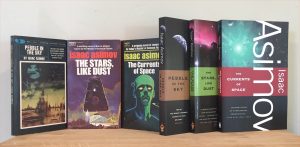[draft]

The third of Asimov’s “Galactic Empire” novels, first published in 1952, opens with a fish out of water situation a bit like that in PEBBLE IN THE SKY. But first there is a prolog as the book opens with a conversation between two unidentified people arguing about taking action against some vaguely identified threat – this is a passage you return to, later in the book, once you understand who those people are and what they were talking about.
And then we begin, with a simpleton, maybe a crazy person, named Rik, a worker at a kyrt mill on the planet Florina. He’s an amnesiac, taken care of by a woman named Valona March who because she is plain has no romantic prospects. He has flashes of memory—that he had a job, that it involved “analyzing Nothing.” And, that everyone on this planet will die.
As in the previous books, each chapter switches point of view to other characters, and in this book the chapter titles are roles – The Foundling, The Townsman, The Librarian, The Rebel, etc. – though as the book goes on, we see that some individual characters play several roles.
The plot moves on as the caretaker Valona takes Rik to the city. Asimov literalizes social structure on Florina, where an Upper City, held up off the ground by thousands of pillars, sits above a Lower City, where the workers live. The Upper City is reserved for Squires, from the planet Sark, which rules over Florina and controls its product, kyrt. (Shades of Dune here.) Asimov craftily avoids explaining why kyrt is such a valuable product until nearly half way through the book.
So Valona takes Rik to a library in the Upper City where he can consult books, hoping to trigger more memories. He recognizes the phrase “analyzing nothing” as being a function of the Institute of Spatio-Analysis … that Rik must have belonged to. But the librarian’s nosiness makes them suspicious, and they flee…. Eventually onto a spaceship, leaving the planet.
Other plots threads involve a scientist, Dr. Selim Junz, who’d gotten an alarming message from one of his analysts but who subsequently disappeared… a year ago. And Terens, a ‘Townsman’ on Florina who oversees the factory where Rik and Valona work, and who found Rik near-naked and drooling in a field… a year ago… and took him to a doctor in the City, a doctor who was killed in a car accident a week later. And: an ambassador from Trantor, Abel, who believes that the only road to galactic peace is for the current Trantorian Empire to become a true Galactic Empire…but by force if necessary.
And several Great Squires on Sark, the planet that oversees Florina, who’ve gotten blackmail notices… a year ago… concerning Florina’s likely destruction.
There’s a significant female character here, a Lady Samia, who happens to be on the spaceship that Valona and Rik escape upon. She fancies herself a detective and takes interest in them. Alas, later in the book, when her hypothesis is disproven, she disappears from the plot.
The resolution of course involves all these characters and plot threads converging. As in THE STARS, LIKE DUST, the villain turns out to be a character we’ve met earlier. The conspiracy theories imagined by the Great Squires are undermined, to their discredit.
But here’s why this is a significant science fiction novel, and not just a projection of ancient politics into outer space, as in the previous book. The reason ‘kyrt’ –- a voluptuous fabric that can only grow on Florina – is so valuable, the reason Rik made a discovery about the “currents of space,” and the threat to Florina, and potentially the whole galaxy, are all interconnected, and all explained by the end. (There are some infodumps here about the nuclear processes that power stars – and how investigations into the threats these ideas imply to the kyrt trade are shut down to preserve that trade. [Just like Republicans shutting down climate change or gun violence research!] And it’s not just this particular circumstance – it’s about a threat that could apply to hundreds of planets a year, considering that humans have colonized millions of planets throughout the galaxy. That much is very plausible; the ‘currents of space’ notion, reasonably plausible.
Again there’s background about the growing galactic empire, and whether Trantor want might to use a dispute between Sark and Florina to take control.
Asimov likes formal structures, and here he daisy-chains the chapters by shifting the focus from one character to the next (though sometime the same character is playing multiple roles), and with a Prolog labeled ‘A Year Before’ and an Epilog labeled ‘A Year After.’
The final pages of the book are notable in showing how Asimov could write a strikingly emotional note to end a story. It’s not quite up there with the finale to “An Ugly Little Boy,” but it shows how his villain, who perhaps was cornered by circumstances, repents.
\\
Asimov’s idea of a futuristic library describes visitors being led to private rooms with ‘readers’ with knobs to bring up menus.





